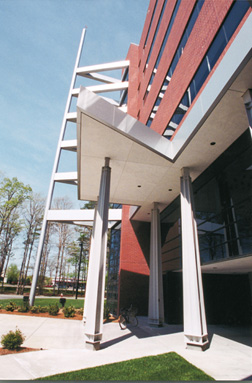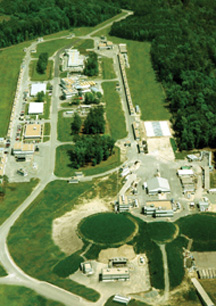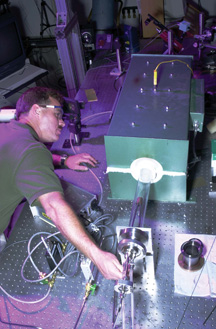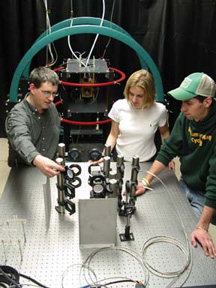Accelerating: The College and J-Lab
 The following article appeared in the Spring/Summer 2005 edition of
the Alumni Magazine. To access the complete magazine (pdf), go to the Alumni Association's Web site. -Ed.
The following article appeared in the Spring/Summer 2005 edition of
the Alumni Magazine. To access the complete magazine (pdf), go to the Alumni Association's Web site. -Ed.
Nuclear physics research isn't much different from a good game of pool. When the cue ball slams into the racked game balls, they scatter, knocking into each other and colliding with the edges of the table.
Scientists from the College of William and Mary and around the world use a similar technique at Thomas Jefferson National Accelerator Facility in Newport News, Va., just 17 miles from campus. Better known as Jefferson Lab, the nuclear physics center is home to the Continuous Electron Beam Accelerator Facility (CEBAF), an underground high-tech machine nearly a mile around. To probe the atom's nucleus, CEBAF focuses electrons into a continuous beam, boosts their energy and shoots them directly into the nuclei. The scattering pieces in this submicroscopic pool game yield clues about the nature of matter itself.
The truth is, 99.9 percent of all mass is made up of protons and neutrons, but scientists don't understand how quarks make up those protons and neutrons. "I don't go to work every day and say, ‘What's the meaning of the universe?'" says Todd D. Averett, an associate professor of physics at William and Mary who conducts research at the lab. "But I do want to understand the basic building blocks of the universe."
Associate Professor of Physics David S. Armstrong is among many William and Mary professors using the Jefferson Lab accelerator. "We don't understand how quarks determine the nature-the size and shape, for example-of protons and neutrons," he says. "At the core of our work, that is the deepest mission. ... With 120 or so colleagues, I'm trying to figure out how these quarks make up the fuzzy, ill-defined edges of the protons and neutrons.""To understand a neutron or a proton ... you look at how it breaks apart," Averett explains. That breaking apart takes place in targets like the ones he makes using hand-blown glass cells and a form of helium. These specialized target cells are made exclusively by Averett at William and Mary and his colleagues at the University of Virginia (U.Va.).
Scientists from the College also use another research tool at Jefferson Lab: the world's most powerful laser that can be tuned to a precise color. It's called a free-electron laser, or FEL (pronounced eff-ee-ell), and is based on the superconducting technology that Jefferson Lab pioneered for accelerating electrons in CEBAF.
Associate Professor of Applied Science Brian C. Holloway and Associate Professor of Physics Anne C. Reilly are among those using the FEL, which, like CEBAF, has a several-year backlog of worldwide demand from scientists waiting to use it. "There are a lot of other lasers," says Holloway, "but this is the only one with the level of power that lets us do what we want to do. It gives us a lot of flexibility in laser-based experiments."
"Brian is collaborating with scientists at NASA to make carbon nanotubes, tiny tubes that are 100 times stronger than steel," says Fred Dylla, adjunct professor of physics at William and Mary and Jefferson Lab's chief technology officer. Dylla runs the FEL.
"We want to be the Lowe's of the nanotechnology world," Holloway explains. "We want to supply people studying nanotechnology with good, high-quality nanotubes in commercial quantities." Nanotechnology is the engineering of electronic circuits and other devices from single atoms and molecules.
Nanotubes could be used to create a strong and transparent replacement for fiberglass, notes Holloway. They could also be used in sensors to detect anthrax or in cages to house new pharmaceuticals that are not stable in an open atmosphere.
Reilly uses the FEL to make high-quality thin-film magnetic materials. "It's a powerful machine that allows us to grow new materials," she says. Her work cannot be duplicated anywhere else in the world. Computer technology offers practical applications for it.
Unlike Holloway and Reilly's work, the research done in Jefferson Lab's accelerator is pure science only. Practical applications may not be known for decades. "Right now, it's experimental curiosity," says Armstrong. "If we discover a new way the quarks go together, that might have a practical application in 50 years."
To illustrate, Armstrong tells of physicists in Cambridge, England, where the electron was discovered in 1897. A sign over their laboratory door read: "To the Electron: May it never be of use to anyone." He points out that, although those who first studied the electron never imagined it would become useful, today those infinitesimal particles allow for the countless commonplace devices we call electronics.
William and Mary and the birth of a national lab
Without the tireless efforts of some of William and Mary's stellar faculty, research like that of Armstrong, Averett, Holloway, Reilly and their colleagues and students might not be taking place locally.
The story of Jefferson Lab begins in the late 1970s when a professor from U.Va., James McCarthy, began sharing his vision for an electron accelerator.
At that time, William and Mary's Hans Christian von Baeyer, currently Chancellor Professor of Physics, was finishing up six years as physics department chair and had headed to Vancouver for a year of research leave. While he was gone, he got a call from then-Provost George R. Healy asking him to become director of the College-run Virginia Associated Research Campus (VARC) in Newport News.
The VARC was founded in the 1960s when Virginia decided to support NASA's decision to build a Space Radiation Effects Laboratory (SREL) based on an accelerator called a cyclotron. A consortium of state universities housed in a building neighboring the SREL, the VARC provided administrative services, offices and laboratories for the facility. After the SREL shut down in 1980, the William and Mary facility in Newport News lacked a mission; it was von Baeyer's goal to find a new one.
Shortly after von Baeyer took over the VARC, McCarthy of U.Va. visited the College to give a talk. "Physics Professor Bob Siegel came to my office very excited and said, ‘Hans, you've got to come hear this man speak,'" remembers von Baeyer.
That day he heard McCarthy talk about an electron accelerator capable of changing the study of nuclear physics. "Right there and then, instantly, in that moment, it became clear to me that I had to get that accelerator to come here," von Baeyer says. "I decided to put all my eggs in one basket."
Von Baeyer and his William and Mary colleagues resolved to do whatever it took to make McCarthy's dream real. "It became clear to us that this project was going to be so big ... that it would exceed the stature of just one university," explains von Baeyer. "What we had to do was found an organization of universities that could support this great project."
Von Baeyer sought advice on starting such an organization from a colleague at Harvard University who had helped form the university consortium that runs Brookhaven National Laboratory. "He said, ‘It's easy. Just put the presidents of three universities in a room, and you've got a consortium,'" recalls von Baeyer.
Following that suggestion, the hopeful scientists brought then-William and Mary President Thomas A. Graves (Honorary Alumnus) together with Frank Hereford, then president of U.Va., and Thomas Law, then president of Virginia State University. What resulted was the Southeastern Universities Research Association, better known as SURA, the organization now involving more than 60 universities that operates Jefferson Lab for the Department of Energy.
‘The dark horse of the competition'
With the formation of SURA, faculty members at the founding
universities needed to make things happen. Von Baeyer and William and
Mary's Franz L. Gross, now professor emeritus of physics and principal
staff scientist at Jefferson Lab, proposed a slate of four officers,
which included McCarthy as vice president, and von Baeyer,
internationally known for his skill in communicating about science, as
secretary. "We were later called the four horsemen," remembers von
Baeyer.
With help from his colleagues at U.Va., McCarthy set out to design that dream accelerator. Gross, a theoretical physicist, began preparing the project's formal scientific justification. Everyone involved focused on obtaining community and political support.
In 1982, a political decision at the national level called for the construction of an electron accelerator. The SURA group was prepared; they had already developed their proposal.
"SURA was considered the underdog in the competition to build the accelerator," says Gross. "We were still considered the amateur in physics." They were competing against major institutions like Massachusetts Institute of Technology (MIT) and Argonne National Laboratory (ANL) near Chicago, Ill. "MIT should've been the shoo-in," Gross recalls. "They wanted to expand the accelerator they already had."
But MIT's proposal ignored the national mood, which called for a more powerful accelerator than one that would only produce 2 billion electron volts of energy. "MIT was too conservative. Two is boring. Four is more interesting than two," says von Baeyer. "There is no doubt in my mind that the whole thing would've been very different if MIT hadn't chosen the number two."
With MIT eliminated, it came down to the SURA and ANL plans, both for accelerators that would operate at 4 billion electron volts. But it would take more than just a scientific plan to win the federal funding.
Thanks to early efforts, SURA had garnered what Gross and von Baeyer call the strongest political support of all the competitors. Virginia Republican Sen. John Warner LL.D. '81, Virginia Secretary of Education John T. Casteen III, who is now president of U.Va., and Charles S. Robb LL.D. '83, who was then the Democratic governor of Virginia, all backed the proposal.
The SURA group also had the backing of their universities. Any research facility needs collaboration with experts, and SURA's plan used that need to its advantage. "When we gave our proposal to the [Department of Energy], we decided it would include asking our universities to promise to fund new professorships in nuclear physics," explains von Baeyer. "We were able to make our proposal with the promise of about three dozen new professorships between all the universities in SURA."
While the national competition over who should build the accelerator intensified, so too did a competition within SURA for where the accelerator should be located. Several sites were considered, including one in Charlottesville near U.Va. and another in Blacksburg near Virginia Tech. Von Baeyer argued for William and Mary's VARC site. "I felt my plan was considered number two," he recalls. "After all, McCarthy had invented this accelerator."
In addition to the land being readily available, von Baeyer's plan had support from the city of Newport News. Jefferson Lab's Fred Dylla gives full credit to von Baeyer for the selection of the VARC location as the site for the accelerator. "He convinced the city to donate the 200 acres of land and also to build a guest house [for visiting researchers], which totaled half a million dollar donation. ... This is one of the major reasons the [Department of Energy] accepted Newport News as the site," he says.
In July 1983, the federal government selected SURA to build the accelerator. As historian of science Catherine Westfall wrote in The Founding of CEBAF, 1979 to 1987, "The dark horse of the competition had come in first."
J-Lab and William and Mary: A win-win situation
Across the William and Mary and Jefferson Lab campuses, faculty echo a
single sentiment: William and Mary is good for Jefferson Lab, and
Jefferson Lab is good for William and Mary.
"Having Jefferson Lab down the road is an unbelievable opportunity," says Todd Averett. "It's the flagship facility for experimental nuclear physics. For its kind, it's the best ... hands down."
While scientists come from all over the world to use the accelerator and the FEL, William and Mary and other Hampton Roads universities share a special relationship with the lab. Why? "Proximity," notes von Baeyer. "We can send young students, postdocs, anyone. That really makes a difference."
The ability to float from research to classroom also helps both institutions move forward, notes Brian Holloway. "People love to do science for the joy of learning. People who love to learn love to help others learn," he explains. That correlation is of great benefit to those who want to learn about physics at William and Mary.
When construction for CEBAF began in the mid-1980s, top scientists from all over the world started moving to Newport News. Among them was J. Dirk Walecka, who came from Stanford University to serve as the lab's first scientific director. He stepped down in 1992 and became a professor of physics at William and Mary. "Dirk Walecka was legendary in this field," says Averett. "Students would flock to take his classes."
The late Nathan Isgur, a leading nuclear physics theorist who was a Distinguished CEBAF Professor at the College and the lab's chief scientist, developed bridge and joint appointment programs to help link Jefferson Lab and universities-including William and Mary-even more closely. Bridge appointments are made by the university whose faculty the scientist will be joining. For the first three to five years, the lab helps pay half of the new faculty member's salary. "Nathan used these appointments to encourage universities to hire new faculty with Jefferson Lab interests," says Franz Gross.
In joint appointments, a scientist's salary is permanently split between the university and the lab. Before retiring from the College, Gross held such a position. A key difference between the two programs is the amount of time the faculty member spends at the lab. In a joint appointment, he/she splits time evenly between the university and the accelerator facility. Scientists with bridge appointments spend about one or two months out of the year there.
In keeping with SURA's commitment to the Department of Energy to create new professorships in conjunction with the lab, Warren W. Buck M.S. '70, Ph.D. '76, a graduate of the physics program and previously a visiting assistant professor of physics at the College, became associate professor of physics at nearby Hampton University (HU). There he created HUGS (Hampton University Graduate Studies) at Jefferson Lab, a selective international summer program that gave students an introduction to research at CEBAF. He was also instrumental in developing HU's Ph.D. in physics.
"It was exciting times in the early days of the lab," says Buck, who is currently chancellor of the University of Washington-Bothell. "Looking at it today gives me great pleasure in knowing what a wonderful resource and tool it is to all."
Increasing the number of students entering graduate programs in experimental physics was one of SURA's goals. A widespread belief at the time was that the U.S. risked falling behind other countries in the study of nuclear physics, explains von Baeyer.
The College's graduate program in physics-the first at William and Mary to grant doctoral degrees-today enrolls about 55 students. "There are bigger graduate programs in physics out there," says Averett. "But Jefferson Lab definitely helps the College attract very good graduate students who see the College's proximity to the lab as an opportunity."
Jefferson Lab helps undergraduate education, too. Students frequently visit the lab for required research projects and honors thesis work. Some complete summer fellowships there. "Because of our proximity to the lab we can have them involved," remarks Armstrong. "They can come here for an afternoon even when they are taking a full load of classes on campus. They get to see what a leading-edge research lab is like."
These and other benefits enjoyed by the College in its relationship with Jefferson Lab are appreciated daily by students and faculty alike. But this year marks a special anniversary of sorts for the William and Mary faculty who helped realize this dream-after all, it was in 1985 that renowned physicist Hermann A. Grunder Sc.D. '92, the lab's first director, and others came to Newport News to begin building the accelerator. As Professor Emeritus Gross says, "The College can take pride in playing an important role in the lab and in science in the United States."
 Skip to main content
Skip to main content

